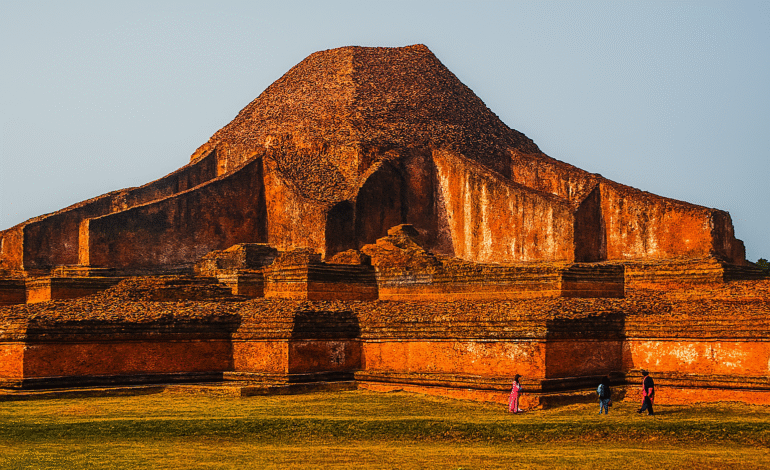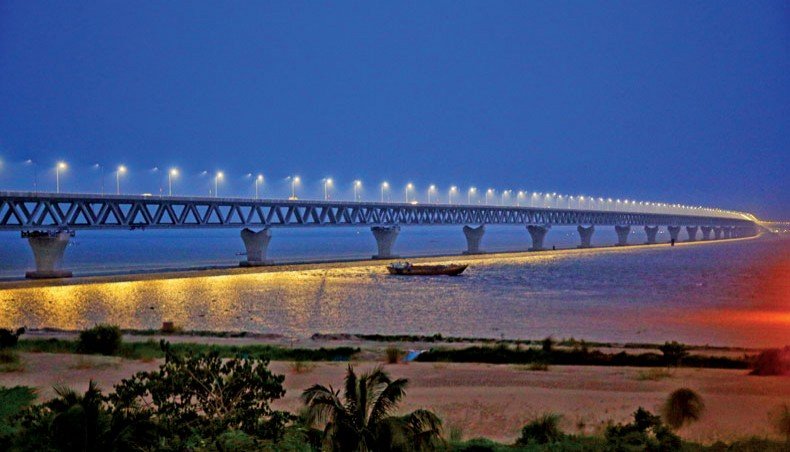Somapura Mahavihara (often called Shompur Boddo Bihar in Bengali usage) is one of Bangladesh’s most iconic archaeological treasures in the quiet village of Paharpur in Badalgachhi Upazila, Naogaon district. As a UNESCO World Heritage site since 1985, it stands as a testament to the country’s deep historical and religious legacy.
Built during the Pala dynasty in the 8th century, this sprawling monastic complex was a premier center of Buddhist learning and architectural innovation. Even today, in its ruined state, Somapura Mahavihara attracts scholars, tourists, and devotees interested in Buddhism, art, and ancient South Asian civilizations.
Historical Background & Significance
The origins of Somapura Mahavihara trace back to the Pala kings of Bengal. Inscriptions and seals indicate that King Dharmapala (circa late 8th century) commissioned its construction, with further extensions under his successors.
During its heyday, the monastery was widely known as a hub of Buddhist scholarship, drawing monks, students, and intellectuals from across the region. Scholars of Buddhism, philosophy, and the arts exchanged ideas here, and the architectural plan influenced monastic constructions as far as Southeast Asia.
Over time, political upheavals, religious transitions, and regional shifts led to the decline of Somapura Mahavihara by the late medieval period. Yet it remained buried or forgotten until archaeological efforts in the 19th and 20th centuries began to uncover its scale and importance.
Architecture & Layout
One of the most remarkable features of Somapura Mahavihara is its quadrangular plan, built around a central courtyard. The outer walls enclosed 177 monastic cells, which opened into a veranda facing inward toward the courtyard.
At the heart of the complex lies the central shrine with a cruciform design and terraced superstructure, rising over multiple levels. The intermediate terraces once held two bands of terracotta plaques that ran the full perimeter, though today only parts remain.
The complex spans approximately 11 hectares (≈27 acres), making it one of the largest monasteries of its time south of the Himalayas.
Decoration is another highlight: terracotta plaques, brick ornamentation, sculptural motifs, and architectural relief work hint at a rich artistic tradition combining Buddhist, Hindu, and local themes.
UNESCO Recognition & Outstanding Value
In 1985, Somapura Mahavihara was inscribed as a UNESCO World Heritage site under the name Ruins of the Buddhist Vihara at Paharpur.
UNESCO cited several sub-criteria:
Its testimony to the rise and spread of Mahayana Buddhism in Bengal from the 7th century onward.
Its architectural significance — the design, layout, and terracotta ornamental features, which influenced monastic architecture across Asia.
The way it embodies interchange of cultural values, seen in the synthesis of artistic motifs and regional influences.
A master plan with a budget of about US$5.6 million was developed in cooperation with UNESCO to guide preservation and restoration efforts.
Threats & Preservation Challenges
Despite its World Heritage status, Somapura Mahavihara faces several threats:
Environmental damage: heavy rainfall, water logging, poor drainage, and soil salinity contribute to deterioration of terracotta plaques and brickwork.
Vegetation & encroachment: unchecked plant growth, tree roots, and human encroachment damage the fragile structures.
Insufficient resources & maintenance: lack of manpower, funding constraints, and inconsistent maintenance have hampered conservation efforts.
Vandalism & public trespassing: without strict controls, unauthorized access or damage to delicate parts can occur.
Scholars and conservationists repeatedly call for more sustained efforts—improved drainage, stricter site management, better funding, and community involvement—to protect the legacy.
Tourism, Education Role Today
Today, Somapura Mahavihara is not just an archaeological site; it’s a window into Bangladesh’s ancient Buddhist past and a magnet for cultural tourism.
Visitors explore the ruins, view exhibits in the local museum, and walk the veranda paths that once linked monk cells. Guided tours—especially during morning or late afternoon hours—help visitors understand the layout and history.
Tourism circuits including heritage tours often integrate Somapura Mahavihara with nearby sites like Mahasthangarh, historic mosques, and rural culture trails.
For local communities, the site offers cultural pride, a source of identity, income from tourism, and educational outreach. Students often visit for history, architecture, and archaeology lessons.
Cultural Significance and Modern Preservation
Today, Shompur Boddho Bihar stands not just as a historical relic but as a living reminder of Bangladesh’s deep-rooted Buddhist heritage. The site attracts thousands of visitors, archaeologists, and heritage enthusiasts each year, inspiring new research and cultural exchange. Modern preservation efforts by the Department of Archaeology and UNESCO have focused on restoring the terracotta plaques and protecting the vast courtyard from erosion. With improved accessibility and digital documentation, Shompur Boddho Bihar continues to educate new generations about the region’s glorious monastic traditions and architectural excellence — symbolizing the harmony between faith, art, and intellect.
Tourism and Economic Impact
In recent years, Shompur Boddho Bihar has emerged as one of Bangladesh’s most popular heritage tourism destinations, attracting both local and international travelers. Its historical depth and serene environment have made it a favorite stop for educational tours, heritage enthusiasts, and Buddhist pilgrims from across South and Southeast Asia. The rise in tourism has also boosted the local economy of Naogaon district — creating jobs, supporting small businesses, and encouraging infrastructure development. As a result, Shompur Boddho Bihar not only preserves ancient wisdom but also plays a vital role in fostering sustainable tourism and community empowerment in northern Bangladesh.
The Enduring Legacy of Somapura Mahavihara
Somapura Mahavihara stands as a bridge between Bangladesh’s Buddhist past and its present cultural landscape. Its architecture, inscriptions, and relics connect local identity to global histories of religion, art, and ancient scholarship.
As Bangladesh continues progressing, preserving Somapura Mahavihara is not just about bricks and mortar—it’s about keeping alive the stories, knowledge, and spiritual currents that shaped the region. With consistent conservation efforts, balanced tourism, and community engagement, this grand monastery can remain not only a relic of history but a living symbol of heritage for generations to come.








